Strategic Supply Chain and Logistics Management Analysis for IKEA
VerifiedAdded on 2020/06/05
|21
|7255
|117
Report
AI Summary
This report provides a comprehensive analysis of IKEA's strategic supply chain and logistics management. It begins by emphasizing the strategic importance of supply chain management to IKEA's board of directors, highlighting five key areas where SCM adds value, such as profitable growth, customer service, financial improvement, material sourcing, and market demand planning. The report then examines the SCM strategies used to enhance IKEA's competitive edge, considering both internal and external environmental factors. The report also includes a procurement plan, a risk assessment plan addressing potential challenges, and alternative strategies. Additionally, it explores the role of information technology in integrating different parts of the supply chain and managing inventory, evaluating its contribution to IKEA's SCM. The report concludes by summarizing the key findings and insights into IKEA's supply chain operations.
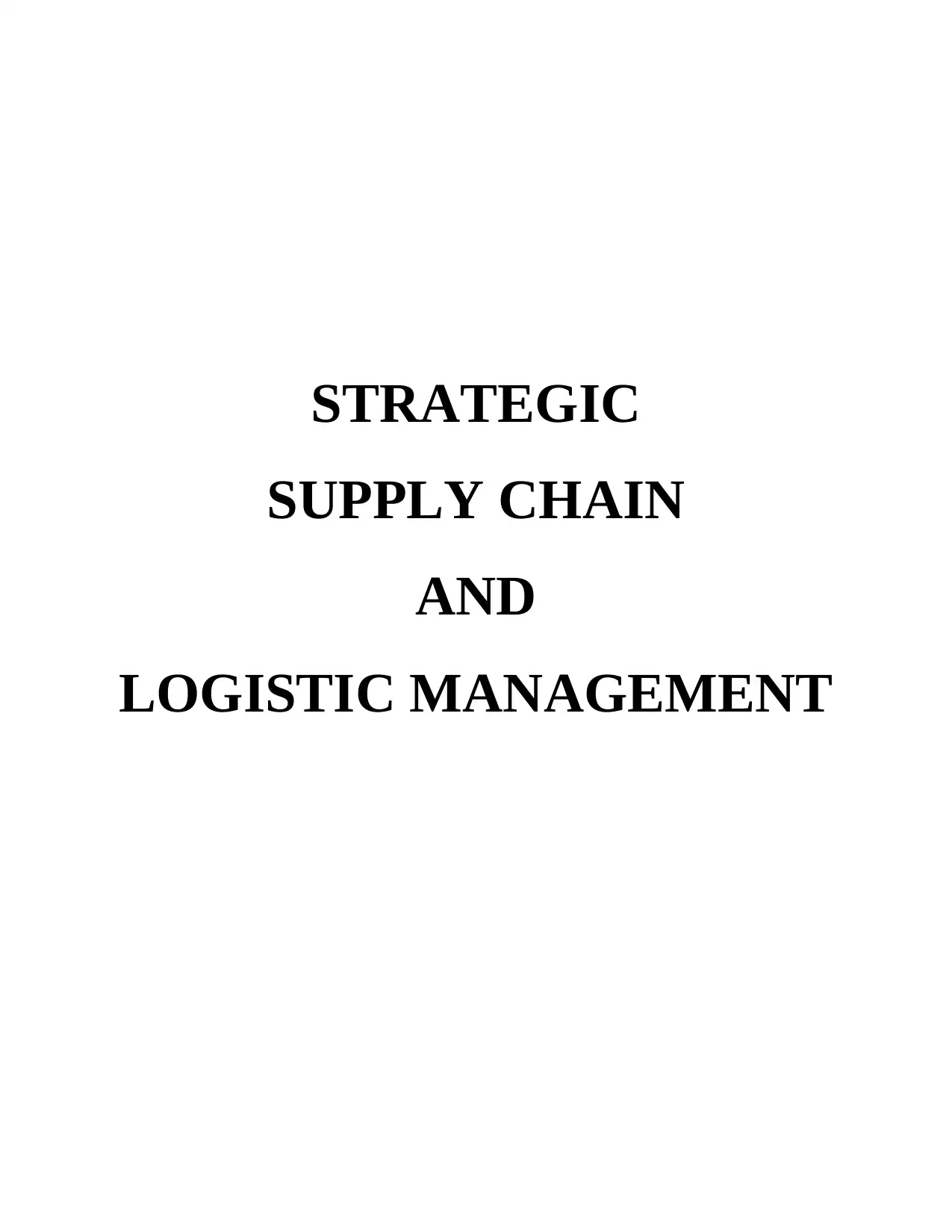
STRATEGIC
SUPPLY CHAIN
AND
LOGISTIC MANAGEMENT
SUPPLY CHAIN
AND
LOGISTIC MANAGEMENT
Paraphrase This Document
Need a fresh take? Get an instant paraphrase of this document with our AI Paraphraser
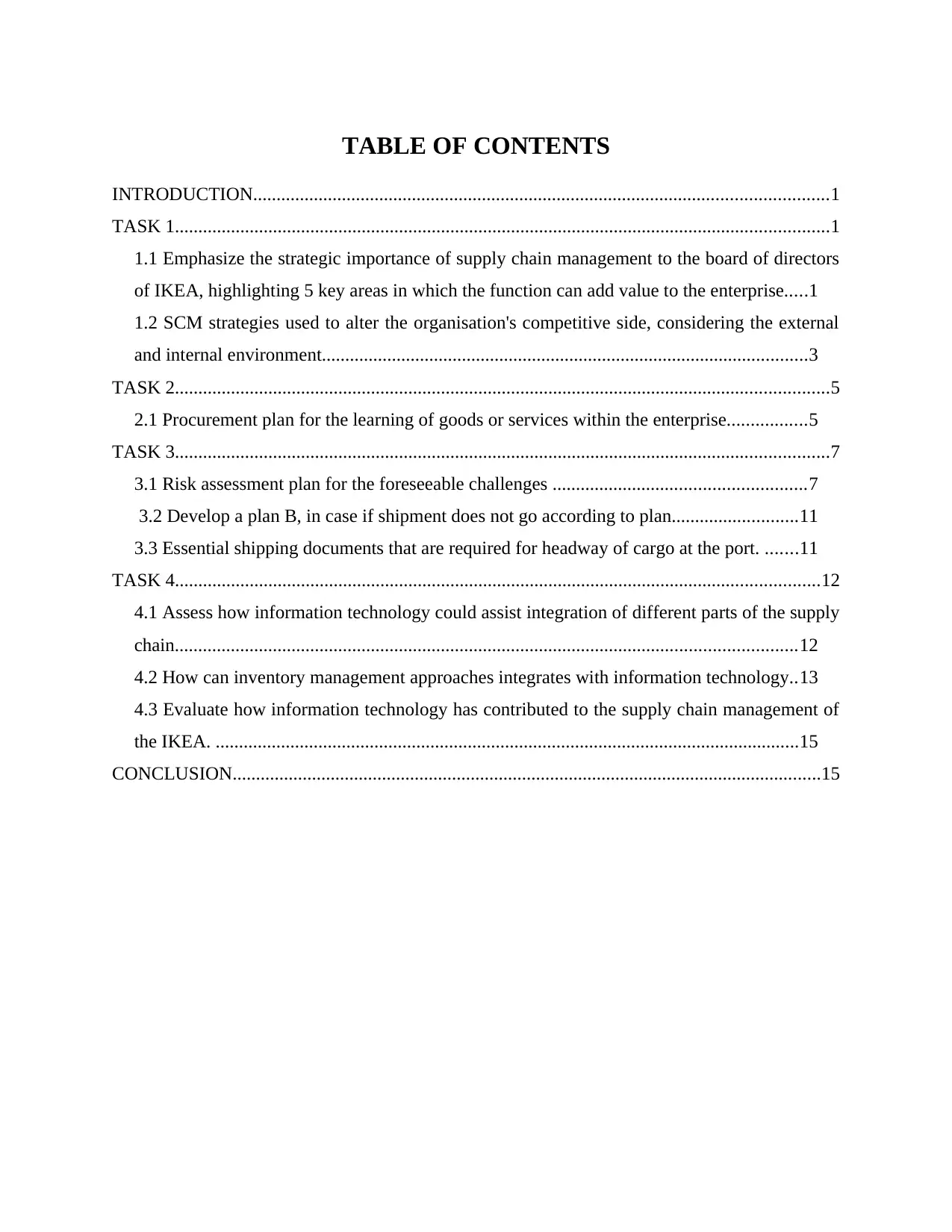
TABLE OF CONTENTS
INTRODUCTION...........................................................................................................................1
TASK 1............................................................................................................................................1
1.1 Emphasize the strategic importance of supply chain management to the board of directors
of IKEA, highlighting 5 key areas in which the function can add value to the enterprise.....1
1.2 SCM strategies used to alter the organisation's competitive side, considering the external
and internal environment........................................................................................................3
TASK 2............................................................................................................................................5
2.1 Procurement plan for the learning of goods or services within the enterprise.................5
TASK 3............................................................................................................................................7
3.1 Risk assessment plan for the foreseeable challenges ......................................................7
3.2 Develop a plan B, in case if shipment does not go according to plan...........................11
3.3 Essential shipping documents that are required for headway of cargo at the port. .......11
TASK 4..........................................................................................................................................12
4.1 Assess how information technology could assist integration of different parts of the supply
chain.....................................................................................................................................12
4.2 How can inventory management approaches integrates with information technology..13
4.3 Evaluate how information technology has contributed to the supply chain management of
the IKEA. .............................................................................................................................15
CONCLUSION..............................................................................................................................15
INTRODUCTION...........................................................................................................................1
TASK 1............................................................................................................................................1
1.1 Emphasize the strategic importance of supply chain management to the board of directors
of IKEA, highlighting 5 key areas in which the function can add value to the enterprise.....1
1.2 SCM strategies used to alter the organisation's competitive side, considering the external
and internal environment........................................................................................................3
TASK 2............................................................................................................................................5
2.1 Procurement plan for the learning of goods or services within the enterprise.................5
TASK 3............................................................................................................................................7
3.1 Risk assessment plan for the foreseeable challenges ......................................................7
3.2 Develop a plan B, in case if shipment does not go according to plan...........................11
3.3 Essential shipping documents that are required for headway of cargo at the port. .......11
TASK 4..........................................................................................................................................12
4.1 Assess how information technology could assist integration of different parts of the supply
chain.....................................................................................................................................12
4.2 How can inventory management approaches integrates with information technology..13
4.3 Evaluate how information technology has contributed to the supply chain management of
the IKEA. .............................................................................................................................15
CONCLUSION..............................................................................................................................15
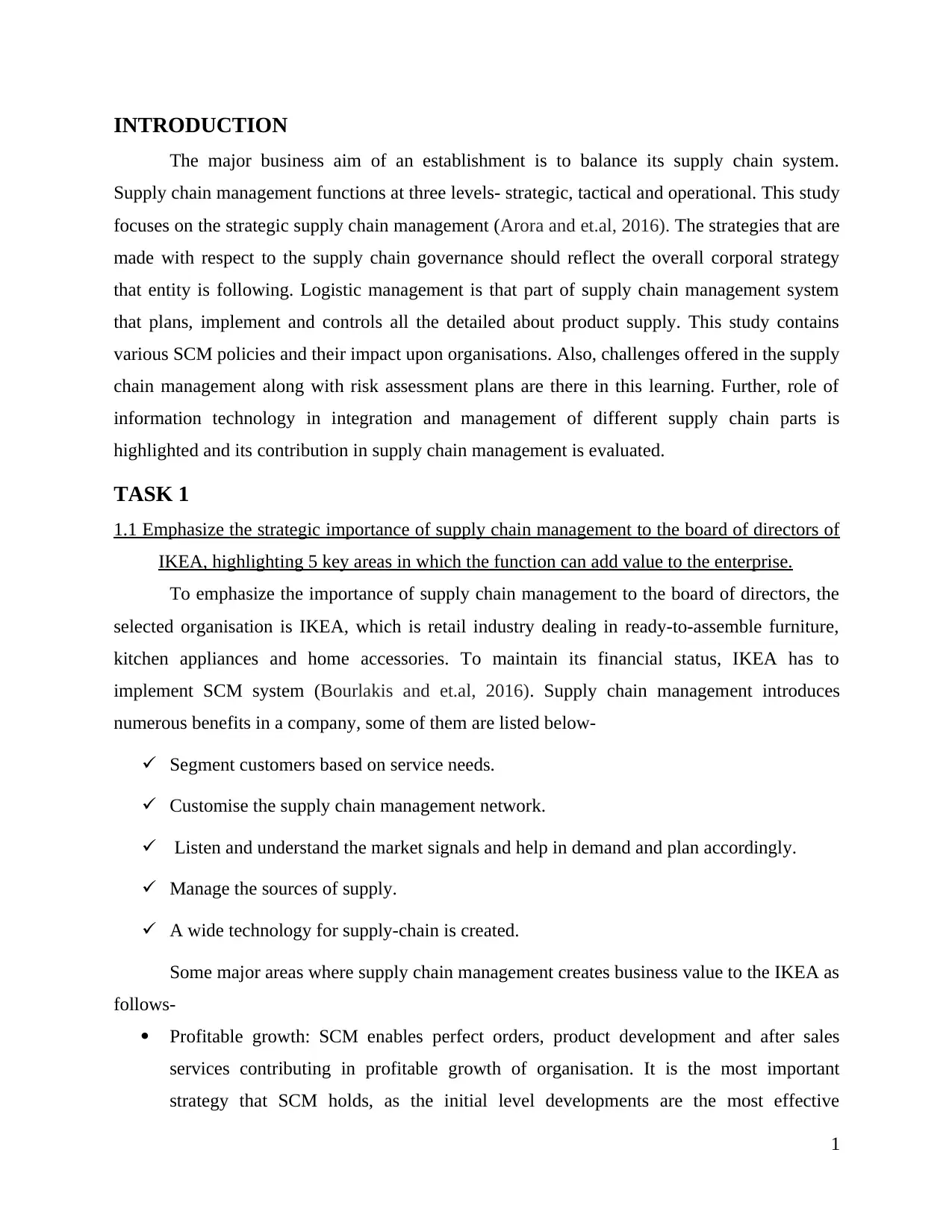
INTRODUCTION
The major business aim of an establishment is to balance its supply chain system.
Supply chain management functions at three levels- strategic, tactical and operational. This study
focuses on the strategic supply chain management (Arora and et.al, 2016). The strategies that are
made with respect to the supply chain governance should reflect the overall corporal strategy
that entity is following. Logistic management is that part of supply chain management system
that plans, implement and controls all the detailed about product supply. This study contains
various SCM policies and their impact upon organisations. Also, challenges offered in the supply
chain management along with risk assessment plans are there in this learning. Further, role of
information technology in integration and management of different supply chain parts is
highlighted and its contribution in supply chain management is evaluated.
TASK 1
1.1 Emphasize the strategic importance of supply chain management to the board of directors of
IKEA, highlighting 5 key areas in which the function can add value to the enterprise.
To emphasize the importance of supply chain management to the board of directors, the
selected organisation is IKEA, which is retail industry dealing in ready-to-assemble furniture,
kitchen appliances and home accessories. To maintain its financial status, IKEA has to
implement SCM system (Bourlakis and et.al, 2016). Supply chain management introduces
numerous benefits in a company, some of them are listed below-
Segment customers based on service needs.
Customise the supply chain management network.
Listen and understand the market signals and help in demand and plan accordingly.
Manage the sources of supply.
A wide technology for supply-chain is created.
Some major areas where supply chain management creates business value to the IKEA as
follows-
Profitable growth: SCM enables perfect orders, product development and after sales
services contributing in profitable growth of organisation. It is the most important
strategy that SCM holds, as the initial level developments are the most effective
1
The major business aim of an establishment is to balance its supply chain system.
Supply chain management functions at three levels- strategic, tactical and operational. This study
focuses on the strategic supply chain management (Arora and et.al, 2016). The strategies that are
made with respect to the supply chain governance should reflect the overall corporal strategy
that entity is following. Logistic management is that part of supply chain management system
that plans, implement and controls all the detailed about product supply. This study contains
various SCM policies and their impact upon organisations. Also, challenges offered in the supply
chain management along with risk assessment plans are there in this learning. Further, role of
information technology in integration and management of different supply chain parts is
highlighted and its contribution in supply chain management is evaluated.
TASK 1
1.1 Emphasize the strategic importance of supply chain management to the board of directors of
IKEA, highlighting 5 key areas in which the function can add value to the enterprise.
To emphasize the importance of supply chain management to the board of directors, the
selected organisation is IKEA, which is retail industry dealing in ready-to-assemble furniture,
kitchen appliances and home accessories. To maintain its financial status, IKEA has to
implement SCM system (Bourlakis and et.al, 2016). Supply chain management introduces
numerous benefits in a company, some of them are listed below-
Segment customers based on service needs.
Customise the supply chain management network.
Listen and understand the market signals and help in demand and plan accordingly.
Manage the sources of supply.
A wide technology for supply-chain is created.
Some major areas where supply chain management creates business value to the IKEA as
follows-
Profitable growth: SCM enables perfect orders, product development and after sales
services contributing in profitable growth of organisation. It is the most important
strategy that SCM holds, as the initial level developments are the most effective
1
⊘ This is a preview!⊘
Do you want full access?
Subscribe today to unlock all pages.

Trusted by 1+ million students worldwide
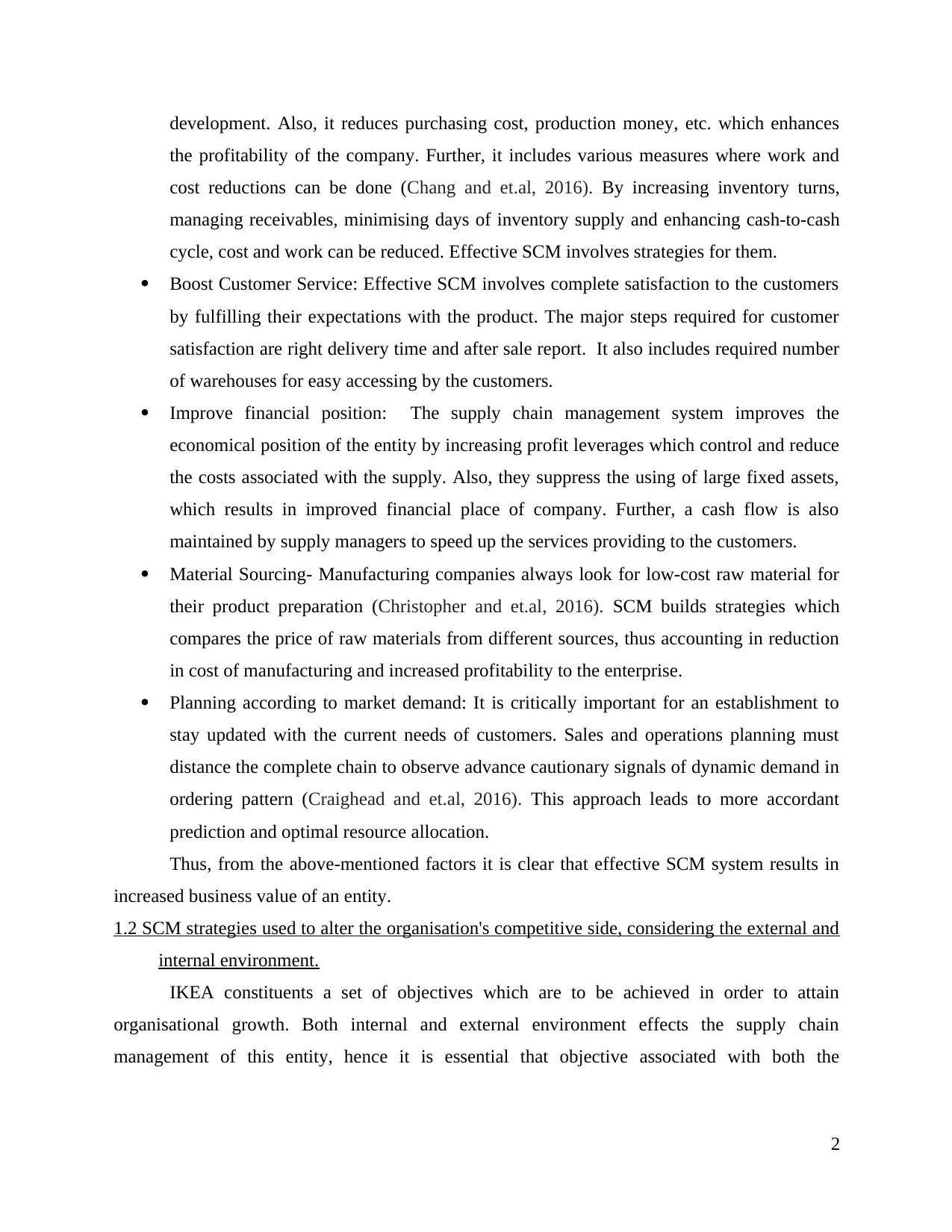
development. Also, it reduces purchasing cost, production money, etc. which enhances
the profitability of the company. Further, it includes various measures where work and
cost reductions can be done (Chang and et.al, 2016). By increasing inventory turns,
managing receivables, minimising days of inventory supply and enhancing cash-to-cash
cycle, cost and work can be reduced. Effective SCM involves strategies for them.
Boost Customer Service: Effective SCM involves complete satisfaction to the customers
by fulfilling their expectations with the product. The major steps required for customer
satisfaction are right delivery time and after sale report. It also includes required number
of warehouses for easy accessing by the customers.
Improve financial position: The supply chain management system improves the
economical position of the entity by increasing profit leverages which control and reduce
the costs associated with the supply. Also, they suppress the using of large fixed assets,
which results in improved financial place of company. Further, a cash flow is also
maintained by supply managers to speed up the services providing to the customers.
Material Sourcing- Manufacturing companies always look for low-cost raw material for
their product preparation (Christopher and et.al, 2016). SCM builds strategies which
compares the price of raw materials from different sources, thus accounting in reduction
in cost of manufacturing and increased profitability to the enterprise.
Planning according to market demand: It is critically important for an establishment to
stay updated with the current needs of customers. Sales and operations planning must
distance the complete chain to observe advance cautionary signals of dynamic demand in
ordering pattern (Craighead and et.al, 2016). This approach leads to more accordant
prediction and optimal resource allocation.
Thus, from the above-mentioned factors it is clear that effective SCM system results in
increased business value of an entity.
1.2 SCM strategies used to alter the organisation's competitive side, considering the external and
internal environment.
IKEA constituents a set of objectives which are to be achieved in order to attain
organisational growth. Both internal and external environment effects the supply chain
management of this entity, hence it is essential that objective associated with both the
2
the profitability of the company. Further, it includes various measures where work and
cost reductions can be done (Chang and et.al, 2016). By increasing inventory turns,
managing receivables, minimising days of inventory supply and enhancing cash-to-cash
cycle, cost and work can be reduced. Effective SCM involves strategies for them.
Boost Customer Service: Effective SCM involves complete satisfaction to the customers
by fulfilling their expectations with the product. The major steps required for customer
satisfaction are right delivery time and after sale report. It also includes required number
of warehouses for easy accessing by the customers.
Improve financial position: The supply chain management system improves the
economical position of the entity by increasing profit leverages which control and reduce
the costs associated with the supply. Also, they suppress the using of large fixed assets,
which results in improved financial place of company. Further, a cash flow is also
maintained by supply managers to speed up the services providing to the customers.
Material Sourcing- Manufacturing companies always look for low-cost raw material for
their product preparation (Christopher and et.al, 2016). SCM builds strategies which
compares the price of raw materials from different sources, thus accounting in reduction
in cost of manufacturing and increased profitability to the enterprise.
Planning according to market demand: It is critically important for an establishment to
stay updated with the current needs of customers. Sales and operations planning must
distance the complete chain to observe advance cautionary signals of dynamic demand in
ordering pattern (Craighead and et.al, 2016). This approach leads to more accordant
prediction and optimal resource allocation.
Thus, from the above-mentioned factors it is clear that effective SCM system results in
increased business value of an entity.
1.2 SCM strategies used to alter the organisation's competitive side, considering the external and
internal environment.
IKEA constituents a set of objectives which are to be achieved in order to attain
organisational growth. Both internal and external environment effects the supply chain
management of this entity, hence it is essential that objective associated with both the
2
Paraphrase This Document
Need a fresh take? Get an instant paraphrase of this document with our AI Paraphraser
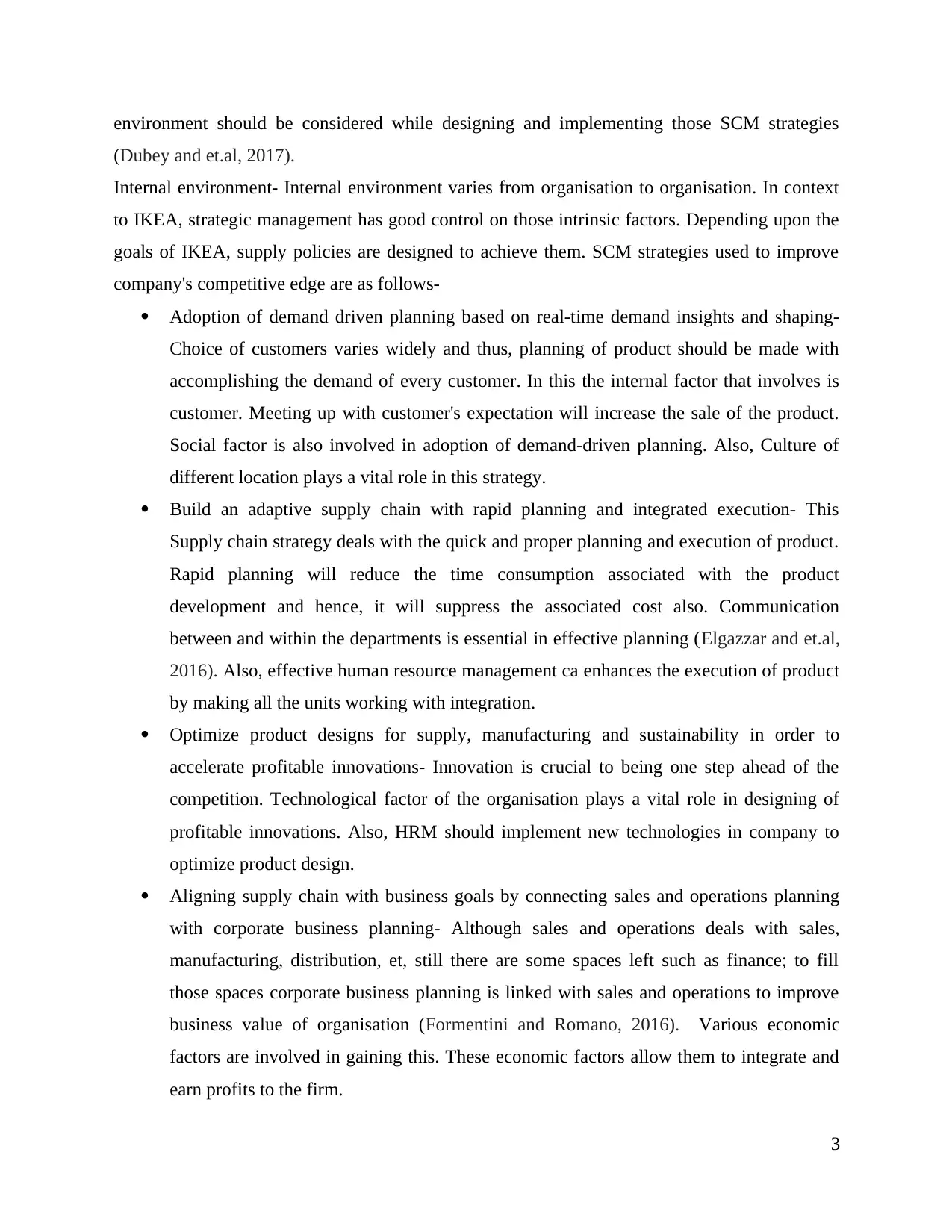
environment should be considered while designing and implementing those SCM strategies
(Dubey and et.al, 2017).
Internal environment- Internal environment varies from organisation to organisation. In context
to IKEA, strategic management has good control on those intrinsic factors. Depending upon the
goals of IKEA, supply policies are designed to achieve them. SCM strategies used to improve
company's competitive edge are as follows-
Adoption of demand driven planning based on real-time demand insights and shaping-
Choice of customers varies widely and thus, planning of product should be made with
accomplishing the demand of every customer. In this the internal factor that involves is
customer. Meeting up with customer's expectation will increase the sale of the product.
Social factor is also involved in adoption of demand-driven planning. Also, Culture of
different location plays a vital role in this strategy.
Build an adaptive supply chain with rapid planning and integrated execution- This
Supply chain strategy deals with the quick and proper planning and execution of product.
Rapid planning will reduce the time consumption associated with the product
development and hence, it will suppress the associated cost also. Communication
between and within the departments is essential in effective planning (Elgazzar and et.al,
2016). Also, effective human resource management ca enhances the execution of product
by making all the units working with integration.
Optimize product designs for supply, manufacturing and sustainability in order to
accelerate profitable innovations- Innovation is crucial to being one step ahead of the
competition. Technological factor of the organisation plays a vital role in designing of
profitable innovations. Also, HRM should implement new technologies in company to
optimize product design.
Aligning supply chain with business goals by connecting sales and operations planning
with corporate business planning- Although sales and operations deals with sales,
manufacturing, distribution, et, still there are some spaces left such as finance; to fill
those spaces corporate business planning is linked with sales and operations to improve
business value of organisation (Formentini and Romano, 2016). Various economic
factors are involved in gaining this. These economic factors allow them to integrate and
earn profits to the firm.
3
(Dubey and et.al, 2017).
Internal environment- Internal environment varies from organisation to organisation. In context
to IKEA, strategic management has good control on those intrinsic factors. Depending upon the
goals of IKEA, supply policies are designed to achieve them. SCM strategies used to improve
company's competitive edge are as follows-
Adoption of demand driven planning based on real-time demand insights and shaping-
Choice of customers varies widely and thus, planning of product should be made with
accomplishing the demand of every customer. In this the internal factor that involves is
customer. Meeting up with customer's expectation will increase the sale of the product.
Social factor is also involved in adoption of demand-driven planning. Also, Culture of
different location plays a vital role in this strategy.
Build an adaptive supply chain with rapid planning and integrated execution- This
Supply chain strategy deals with the quick and proper planning and execution of product.
Rapid planning will reduce the time consumption associated with the product
development and hence, it will suppress the associated cost also. Communication
between and within the departments is essential in effective planning (Elgazzar and et.al,
2016). Also, effective human resource management ca enhances the execution of product
by making all the units working with integration.
Optimize product designs for supply, manufacturing and sustainability in order to
accelerate profitable innovations- Innovation is crucial to being one step ahead of the
competition. Technological factor of the organisation plays a vital role in designing of
profitable innovations. Also, HRM should implement new technologies in company to
optimize product design.
Aligning supply chain with business goals by connecting sales and operations planning
with corporate business planning- Although sales and operations deals with sales,
manufacturing, distribution, et, still there are some spaces left such as finance; to fill
those spaces corporate business planning is linked with sales and operations to improve
business value of organisation (Formentini and Romano, 2016). Various economic
factors are involved in gaining this. These economic factors allow them to integrate and
earn profits to the firm.
3
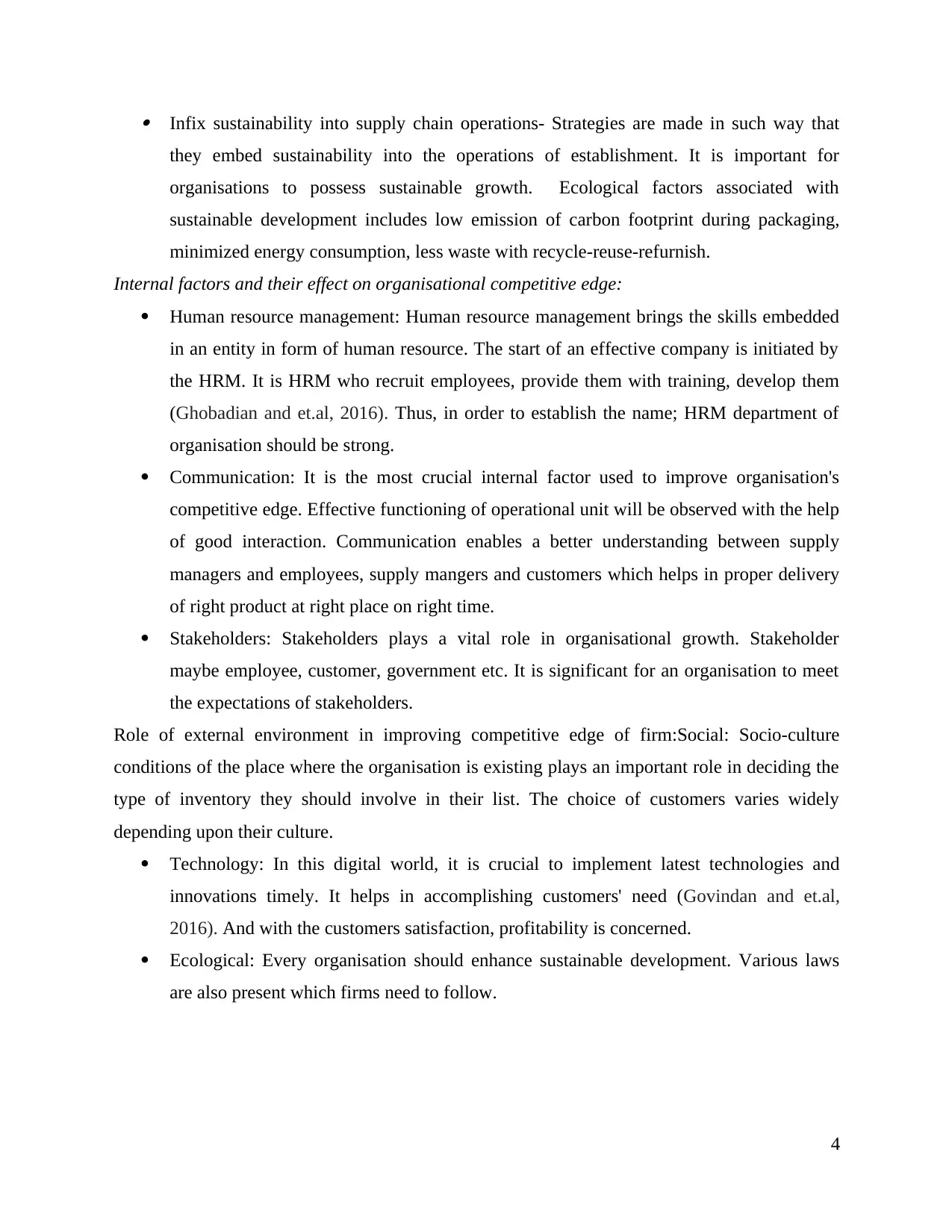
Infix sustainability into supply chain operations- Strategies are made in such way that
they embed sustainability into the operations of establishment. It is important for
organisations to possess sustainable growth. Ecological factors associated with
sustainable development includes low emission of carbon footprint during packaging,
minimized energy consumption, less waste with recycle-reuse-refurnish.
Internal factors and their effect on organisational competitive edge:
Human resource management: Human resource management brings the skills embedded
in an entity in form of human resource. The start of an effective company is initiated by
the HRM. It is HRM who recruit employees, provide them with training, develop them
(Ghobadian and et.al, 2016). Thus, in order to establish the name; HRM department of
organisation should be strong.
Communication: It is the most crucial internal factor used to improve organisation's
competitive edge. Effective functioning of operational unit will be observed with the help
of good interaction. Communication enables a better understanding between supply
managers and employees, supply mangers and customers which helps in proper delivery
of right product at right place on right time.
Stakeholders: Stakeholders plays a vital role in organisational growth. Stakeholder
maybe employee, customer, government etc. It is significant for an organisation to meet
the expectations of stakeholders.
Role of external environment in improving competitive edge of firm:Social: Socio-culture
conditions of the place where the organisation is existing plays an important role in deciding the
type of inventory they should involve in their list. The choice of customers varies widely
depending upon their culture.
Technology: In this digital world, it is crucial to implement latest technologies and
innovations timely. It helps in accomplishing customers' need (Govindan and et.al,
2016). And with the customers satisfaction, profitability is concerned.
Ecological: Every organisation should enhance sustainable development. Various laws
are also present which firms need to follow.
4
they embed sustainability into the operations of establishment. It is important for
organisations to possess sustainable growth. Ecological factors associated with
sustainable development includes low emission of carbon footprint during packaging,
minimized energy consumption, less waste with recycle-reuse-refurnish.
Internal factors and their effect on organisational competitive edge:
Human resource management: Human resource management brings the skills embedded
in an entity in form of human resource. The start of an effective company is initiated by
the HRM. It is HRM who recruit employees, provide them with training, develop them
(Ghobadian and et.al, 2016). Thus, in order to establish the name; HRM department of
organisation should be strong.
Communication: It is the most crucial internal factor used to improve organisation's
competitive edge. Effective functioning of operational unit will be observed with the help
of good interaction. Communication enables a better understanding between supply
managers and employees, supply mangers and customers which helps in proper delivery
of right product at right place on right time.
Stakeholders: Stakeholders plays a vital role in organisational growth. Stakeholder
maybe employee, customer, government etc. It is significant for an organisation to meet
the expectations of stakeholders.
Role of external environment in improving competitive edge of firm:Social: Socio-culture
conditions of the place where the organisation is existing plays an important role in deciding the
type of inventory they should involve in their list. The choice of customers varies widely
depending upon their culture.
Technology: In this digital world, it is crucial to implement latest technologies and
innovations timely. It helps in accomplishing customers' need (Govindan and et.al,
2016). And with the customers satisfaction, profitability is concerned.
Ecological: Every organisation should enhance sustainable development. Various laws
are also present which firms need to follow.
4
⊘ This is a preview!⊘
Do you want full access?
Subscribe today to unlock all pages.

Trusted by 1+ million students worldwide
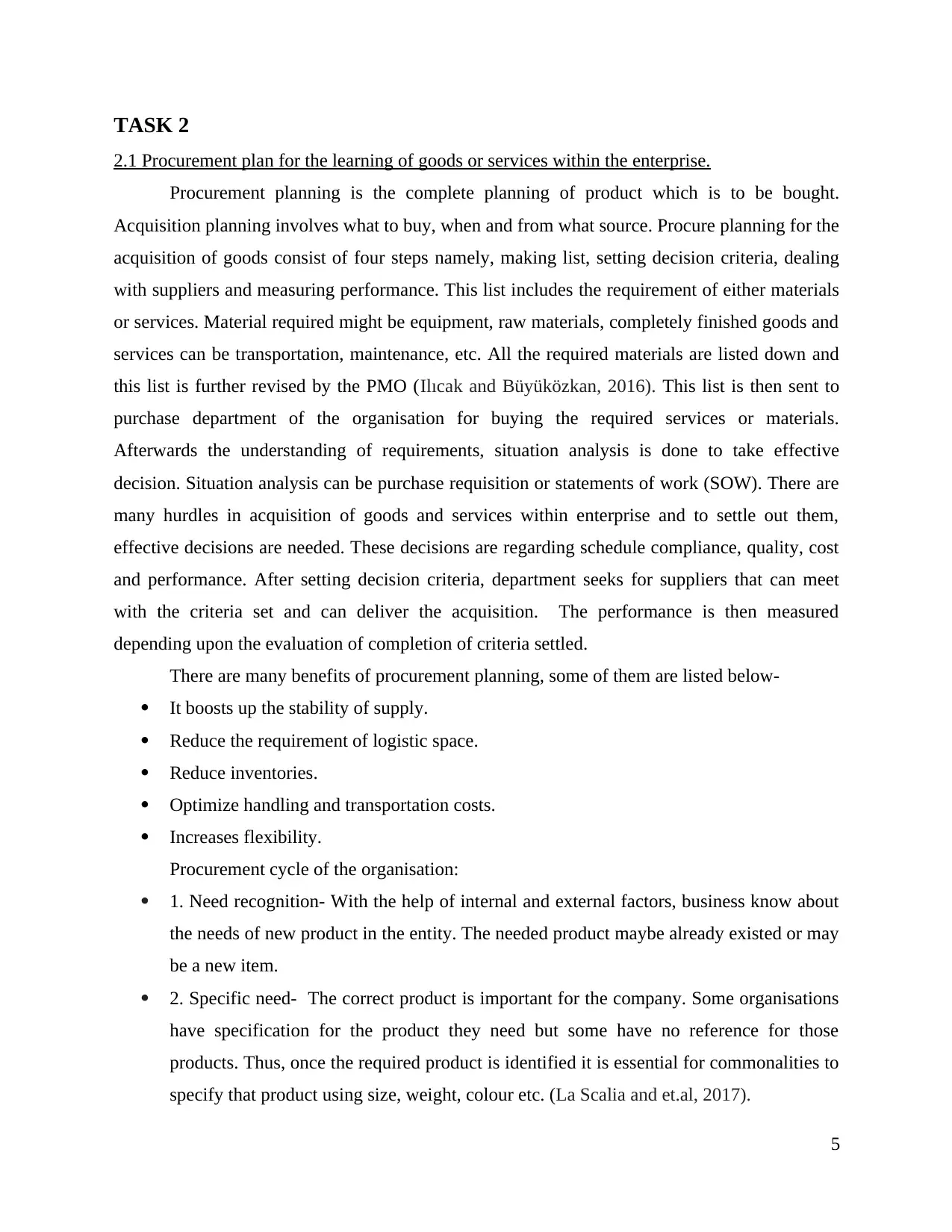
TASK 2
2.1 Procurement plan for the learning of goods or services within the enterprise.
Procurement planning is the complete planning of product which is to be bought.
Acquisition planning involves what to buy, when and from what source. Procure planning for the
acquisition of goods consist of four steps namely, making list, setting decision criteria, dealing
with suppliers and measuring performance. This list includes the requirement of either materials
or services. Material required might be equipment, raw materials, completely finished goods and
services can be transportation, maintenance, etc. All the required materials are listed down and
this list is further revised by the PMO (Ilıcak and Büyüközkan, 2016). This list is then sent to
purchase department of the organisation for buying the required services or materials.
Afterwards the understanding of requirements, situation analysis is done to take effective
decision. Situation analysis can be purchase requisition or statements of work (SOW). There are
many hurdles in acquisition of goods and services within enterprise and to settle out them,
effective decisions are needed. These decisions are regarding schedule compliance, quality, cost
and performance. After setting decision criteria, department seeks for suppliers that can meet
with the criteria set and can deliver the acquisition. The performance is then measured
depending upon the evaluation of completion of criteria settled.
There are many benefits of procurement planning, some of them are listed below-
It boosts up the stability of supply.
Reduce the requirement of logistic space.
Reduce inventories.
Optimize handling and transportation costs.
Increases flexibility.
Procurement cycle of the organisation:
1. Need recognition- With the help of internal and external factors, business know about
the needs of new product in the entity. The needed product maybe already existed or may
be a new item.
2. Specific need- The correct product is important for the company. Some organisations
have specification for the product they need but some have no reference for those
products. Thus, once the required product is identified it is essential for commonalities to
specify that product using size, weight, colour etc. (La Scalia and et.al, 2017).
5
2.1 Procurement plan for the learning of goods or services within the enterprise.
Procurement planning is the complete planning of product which is to be bought.
Acquisition planning involves what to buy, when and from what source. Procure planning for the
acquisition of goods consist of four steps namely, making list, setting decision criteria, dealing
with suppliers and measuring performance. This list includes the requirement of either materials
or services. Material required might be equipment, raw materials, completely finished goods and
services can be transportation, maintenance, etc. All the required materials are listed down and
this list is further revised by the PMO (Ilıcak and Büyüközkan, 2016). This list is then sent to
purchase department of the organisation for buying the required services or materials.
Afterwards the understanding of requirements, situation analysis is done to take effective
decision. Situation analysis can be purchase requisition or statements of work (SOW). There are
many hurdles in acquisition of goods and services within enterprise and to settle out them,
effective decisions are needed. These decisions are regarding schedule compliance, quality, cost
and performance. After setting decision criteria, department seeks for suppliers that can meet
with the criteria set and can deliver the acquisition. The performance is then measured
depending upon the evaluation of completion of criteria settled.
There are many benefits of procurement planning, some of them are listed below-
It boosts up the stability of supply.
Reduce the requirement of logistic space.
Reduce inventories.
Optimize handling and transportation costs.
Increases flexibility.
Procurement cycle of the organisation:
1. Need recognition- With the help of internal and external factors, business know about
the needs of new product in the entity. The needed product maybe already existed or may
be a new item.
2. Specific need- The correct product is important for the company. Some organisations
have specification for the product they need but some have no reference for those
products. Thus, once the required product is identified it is essential for commonalities to
specify that product using size, weight, colour etc. (La Scalia and et.al, 2017).
5
Paraphrase This Document
Need a fresh take? Get an instant paraphrase of this document with our AI Paraphraser
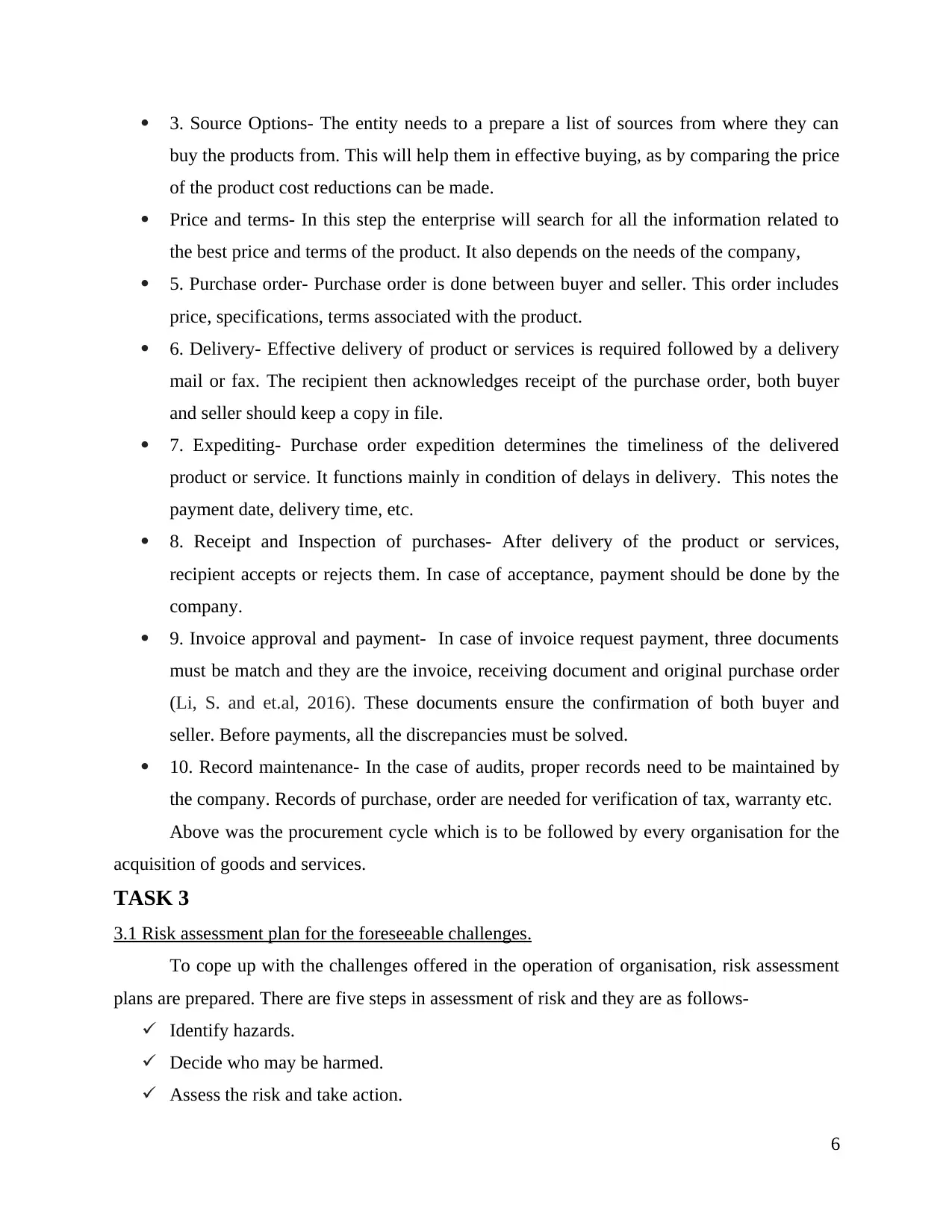
3. Source Options- The entity needs to a prepare a list of sources from where they can
buy the products from. This will help them in effective buying, as by comparing the price
of the product cost reductions can be made.
Price and terms- In this step the enterprise will search for all the information related to
the best price and terms of the product. It also depends on the needs of the company,
5. Purchase order- Purchase order is done between buyer and seller. This order includes
price, specifications, terms associated with the product.
6. Delivery- Effective delivery of product or services is required followed by a delivery
mail or fax. The recipient then acknowledges receipt of the purchase order, both buyer
and seller should keep a copy in file.
7. Expediting- Purchase order expedition determines the timeliness of the delivered
product or service. It functions mainly in condition of delays in delivery. This notes the
payment date, delivery time, etc.
8. Receipt and Inspection of purchases- After delivery of the product or services,
recipient accepts or rejects them. In case of acceptance, payment should be done by the
company.
9. Invoice approval and payment- In case of invoice request payment, three documents
must be match and they are the invoice, receiving document and original purchase order
(Li, S. and et.al, 2016). These documents ensure the confirmation of both buyer and
seller. Before payments, all the discrepancies must be solved.
10. Record maintenance- In the case of audits, proper records need to be maintained by
the company. Records of purchase, order are needed for verification of tax, warranty etc.
Above was the procurement cycle which is to be followed by every organisation for the
acquisition of goods and services.
TASK 3
3.1 Risk assessment plan for the foreseeable challenges.
To cope up with the challenges offered in the operation of organisation, risk assessment
plans are prepared. There are five steps in assessment of risk and they are as follows-
Identify hazards.
Decide who may be harmed.
Assess the risk and take action.
6
buy the products from. This will help them in effective buying, as by comparing the price
of the product cost reductions can be made.
Price and terms- In this step the enterprise will search for all the information related to
the best price and terms of the product. It also depends on the needs of the company,
5. Purchase order- Purchase order is done between buyer and seller. This order includes
price, specifications, terms associated with the product.
6. Delivery- Effective delivery of product or services is required followed by a delivery
mail or fax. The recipient then acknowledges receipt of the purchase order, both buyer
and seller should keep a copy in file.
7. Expediting- Purchase order expedition determines the timeliness of the delivered
product or service. It functions mainly in condition of delays in delivery. This notes the
payment date, delivery time, etc.
8. Receipt and Inspection of purchases- After delivery of the product or services,
recipient accepts or rejects them. In case of acceptance, payment should be done by the
company.
9. Invoice approval and payment- In case of invoice request payment, three documents
must be match and they are the invoice, receiving document and original purchase order
(Li, S. and et.al, 2016). These documents ensure the confirmation of both buyer and
seller. Before payments, all the discrepancies must be solved.
10. Record maintenance- In the case of audits, proper records need to be maintained by
the company. Records of purchase, order are needed for verification of tax, warranty etc.
Above was the procurement cycle which is to be followed by every organisation for the
acquisition of goods and services.
TASK 3
3.1 Risk assessment plan for the foreseeable challenges.
To cope up with the challenges offered in the operation of organisation, risk assessment
plans are prepared. There are five steps in assessment of risk and they are as follows-
Identify hazards.
Decide who may be harmed.
Assess the risk and take action.
6
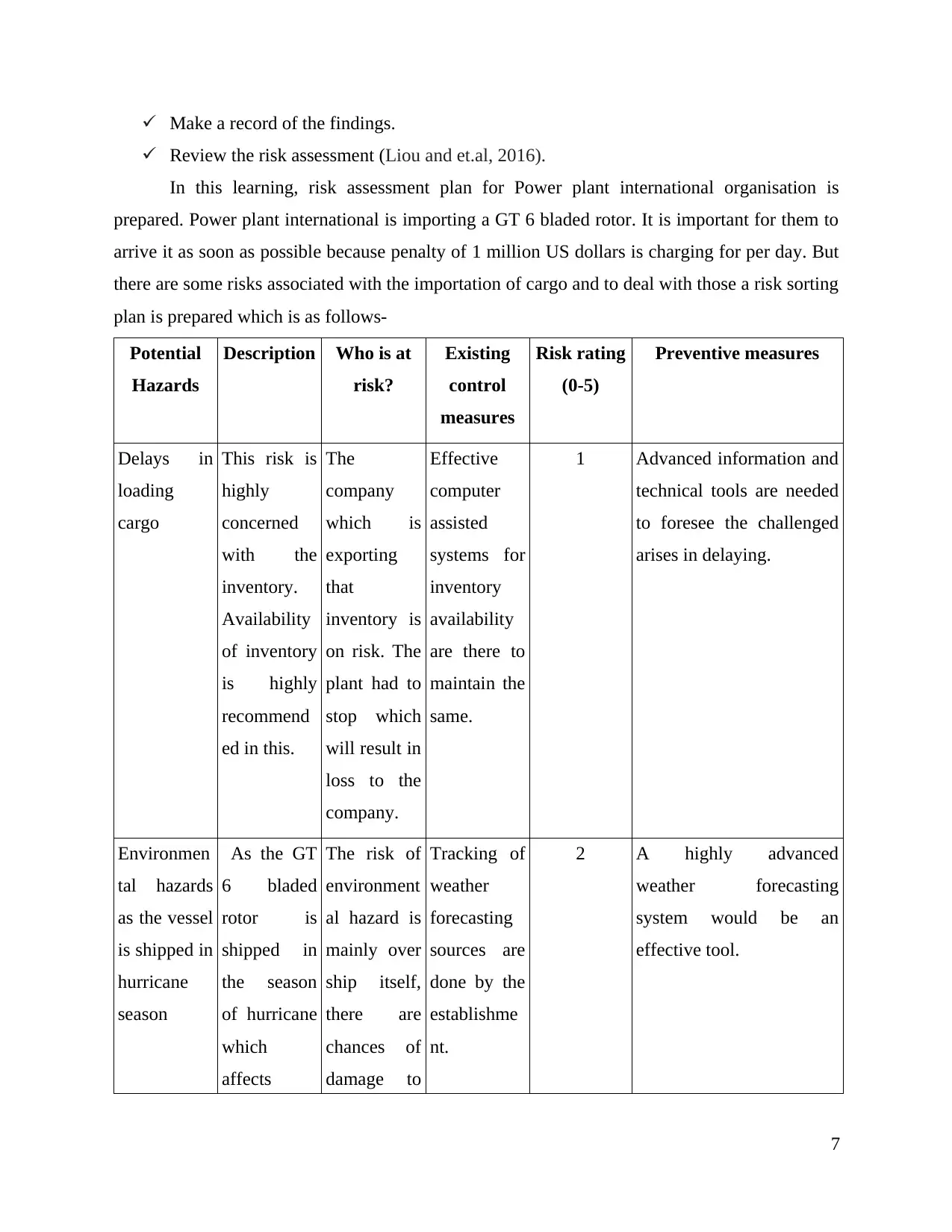
Make a record of the findings.
Review the risk assessment (Liou and et.al, 2016).
In this learning, risk assessment plan for Power plant international organisation is
prepared. Power plant international is importing a GT 6 bladed rotor. It is important for them to
arrive it as soon as possible because penalty of 1 million US dollars is charging for per day. But
there are some risks associated with the importation of cargo and to deal with those a risk sorting
plan is prepared which is as follows-
Potential
Hazards
Description Who is at
risk?
Existing
control
measures
Risk rating
(0-5)
Preventive measures
Delays in
loading
cargo
This risk is
highly
concerned
with the
inventory.
Availability
of inventory
is highly
recommend
ed in this.
The
company
which is
exporting
that
inventory is
on risk. The
plant had to
stop which
will result in
loss to the
company.
Effective
computer
assisted
systems for
inventory
availability
are there to
maintain the
same.
1 Advanced information and
technical tools are needed
to foresee the challenged
arises in delaying.
Environmen
tal hazards
as the vessel
is shipped in
hurricane
season
As the GT
6 bladed
rotor is
shipped in
the season
of hurricane
which
affects
The risk of
environment
al hazard is
mainly over
ship itself,
there are
chances of
damage to
Tracking of
weather
forecasting
sources are
done by the
establishme
nt.
2 A highly advanced
weather forecasting
system would be an
effective tool.
7
Review the risk assessment (Liou and et.al, 2016).
In this learning, risk assessment plan for Power plant international organisation is
prepared. Power plant international is importing a GT 6 bladed rotor. It is important for them to
arrive it as soon as possible because penalty of 1 million US dollars is charging for per day. But
there are some risks associated with the importation of cargo and to deal with those a risk sorting
plan is prepared which is as follows-
Potential
Hazards
Description Who is at
risk?
Existing
control
measures
Risk rating
(0-5)
Preventive measures
Delays in
loading
cargo
This risk is
highly
concerned
with the
inventory.
Availability
of inventory
is highly
recommend
ed in this.
The
company
which is
exporting
that
inventory is
on risk. The
plant had to
stop which
will result in
loss to the
company.
Effective
computer
assisted
systems for
inventory
availability
are there to
maintain the
same.
1 Advanced information and
technical tools are needed
to foresee the challenged
arises in delaying.
Environmen
tal hazards
as the vessel
is shipped in
hurricane
season
As the GT
6 bladed
rotor is
shipped in
the season
of hurricane
which
affects
The risk of
environment
al hazard is
mainly over
ship itself,
there are
chances of
damage to
Tracking of
weather
forecasting
sources are
done by the
establishme
nt.
2 A highly advanced
weather forecasting
system would be an
effective tool.
7
⊘ This is a preview!⊘
Do you want full access?
Subscribe today to unlock all pages.

Trusted by 1+ million students worldwide
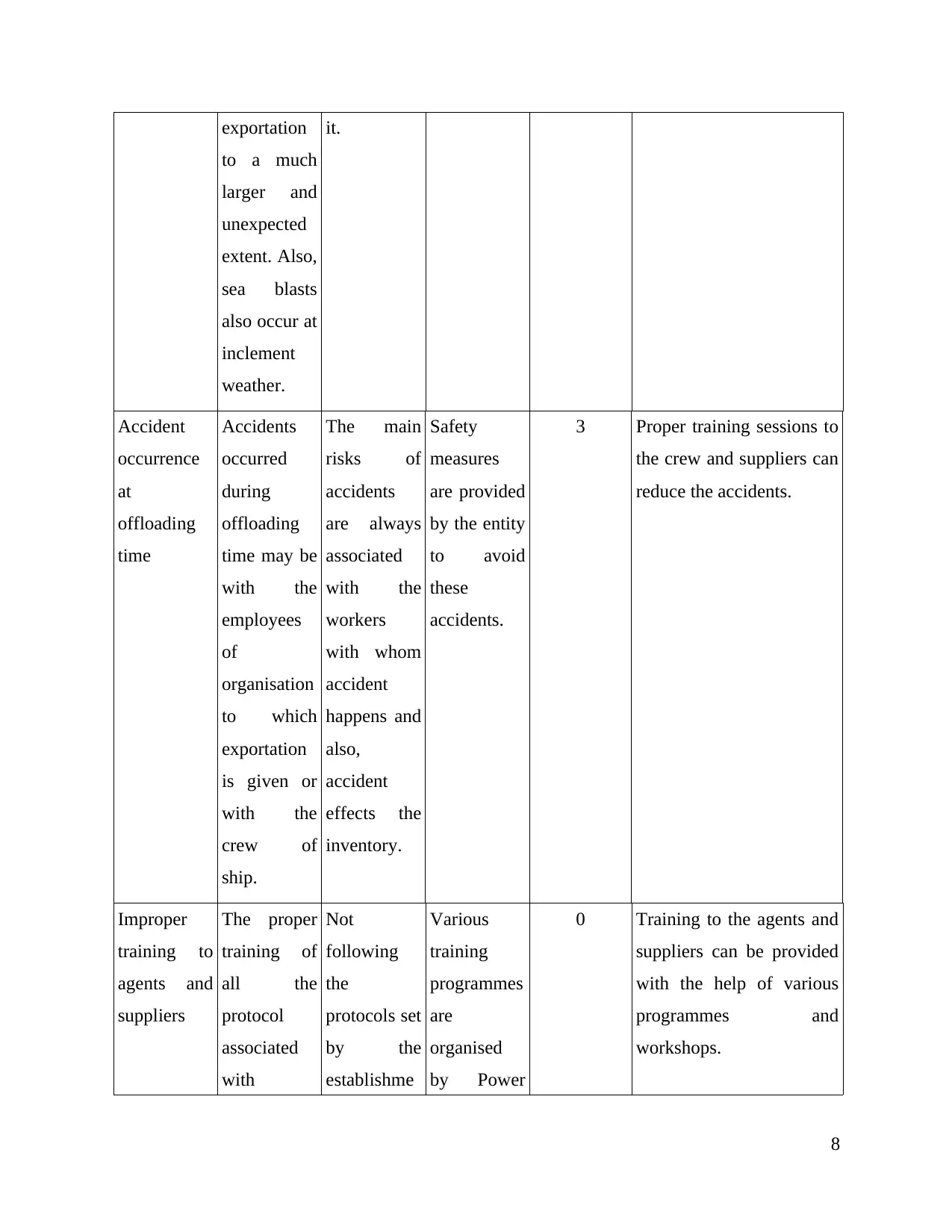
exportation
to a much
larger and
unexpected
extent. Also,
sea blasts
also occur at
inclement
weather.
it.
Accident
occurrence
at
offloading
time
Accidents
occurred
during
offloading
time may be
with the
employees
of
organisation
to which
exportation
is given or
with the
crew of
ship.
The main
risks of
accidents
are always
associated
with the
workers
with whom
accident
happens and
also,
accident
effects the
inventory.
Safety
measures
are provided
by the entity
to avoid
these
accidents.
3 Proper training sessions to
the crew and suppliers can
reduce the accidents.
Improper
training to
agents and
suppliers
The proper
training of
all the
protocol
associated
with
Not
following
the
protocols set
by the
establishme
Various
training
programmes
are
organised
by Power
0 Training to the agents and
suppliers can be provided
with the help of various
programmes and
workshops.
8
to a much
larger and
unexpected
extent. Also,
sea blasts
also occur at
inclement
weather.
it.
Accident
occurrence
at
offloading
time
Accidents
occurred
during
offloading
time may be
with the
employees
of
organisation
to which
exportation
is given or
with the
crew of
ship.
The main
risks of
accidents
are always
associated
with the
workers
with whom
accident
happens and
also,
accident
effects the
inventory.
Safety
measures
are provided
by the entity
to avoid
these
accidents.
3 Proper training sessions to
the crew and suppliers can
reduce the accidents.
Improper
training to
agents and
suppliers
The proper
training of
all the
protocol
associated
with
Not
following
the
protocols set
by the
establishme
Various
training
programmes
are
organised
by Power
0 Training to the agents and
suppliers can be provided
with the help of various
programmes and
workshops.
8
Paraphrase This Document
Need a fresh take? Get an instant paraphrase of this document with our AI Paraphraser
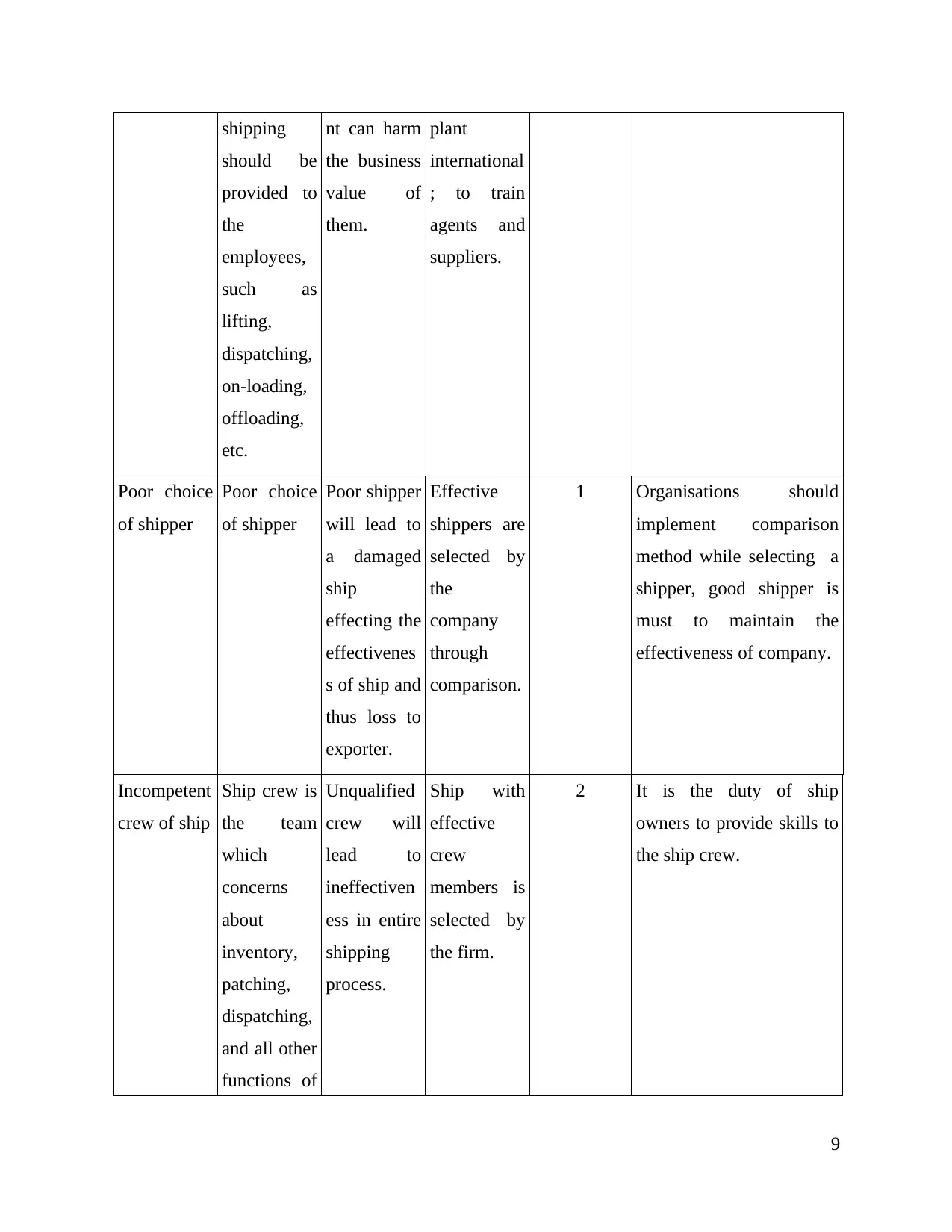
shipping
should be
provided to
the
employees,
such as
lifting,
dispatching,
on-loading,
offloading,
etc.
nt can harm
the business
value of
them.
plant
international
; to train
agents and
suppliers.
Poor choice
of shipper
Poor choice
of shipper
Poor shipper
will lead to
a damaged
ship
effecting the
effectivenes
s of ship and
thus loss to
exporter.
Effective
shippers are
selected by
the
company
through
comparison.
1 Organisations should
implement comparison
method while selecting a
shipper, good shipper is
must to maintain the
effectiveness of company.
Incompetent
crew of ship
Ship crew is
the team
which
concerns
about
inventory,
patching,
dispatching,
and all other
functions of
Unqualified
crew will
lead to
ineffectiven
ess in entire
shipping
process.
Ship with
effective
crew
members is
selected by
the firm.
2 It is the duty of ship
owners to provide skills to
the ship crew.
9
should be
provided to
the
employees,
such as
lifting,
dispatching,
on-loading,
offloading,
etc.
nt can harm
the business
value of
them.
plant
international
; to train
agents and
suppliers.
Poor choice
of shipper
Poor choice
of shipper
Poor shipper
will lead to
a damaged
ship
effecting the
effectivenes
s of ship and
thus loss to
exporter.
Effective
shippers are
selected by
the
company
through
comparison.
1 Organisations should
implement comparison
method while selecting a
shipper, good shipper is
must to maintain the
effectiveness of company.
Incompetent
crew of ship
Ship crew is
the team
which
concerns
about
inventory,
patching,
dispatching,
and all other
functions of
Unqualified
crew will
lead to
ineffectiven
ess in entire
shipping
process.
Ship with
effective
crew
members is
selected by
the firm.
2 It is the duty of ship
owners to provide skills to
the ship crew.
9
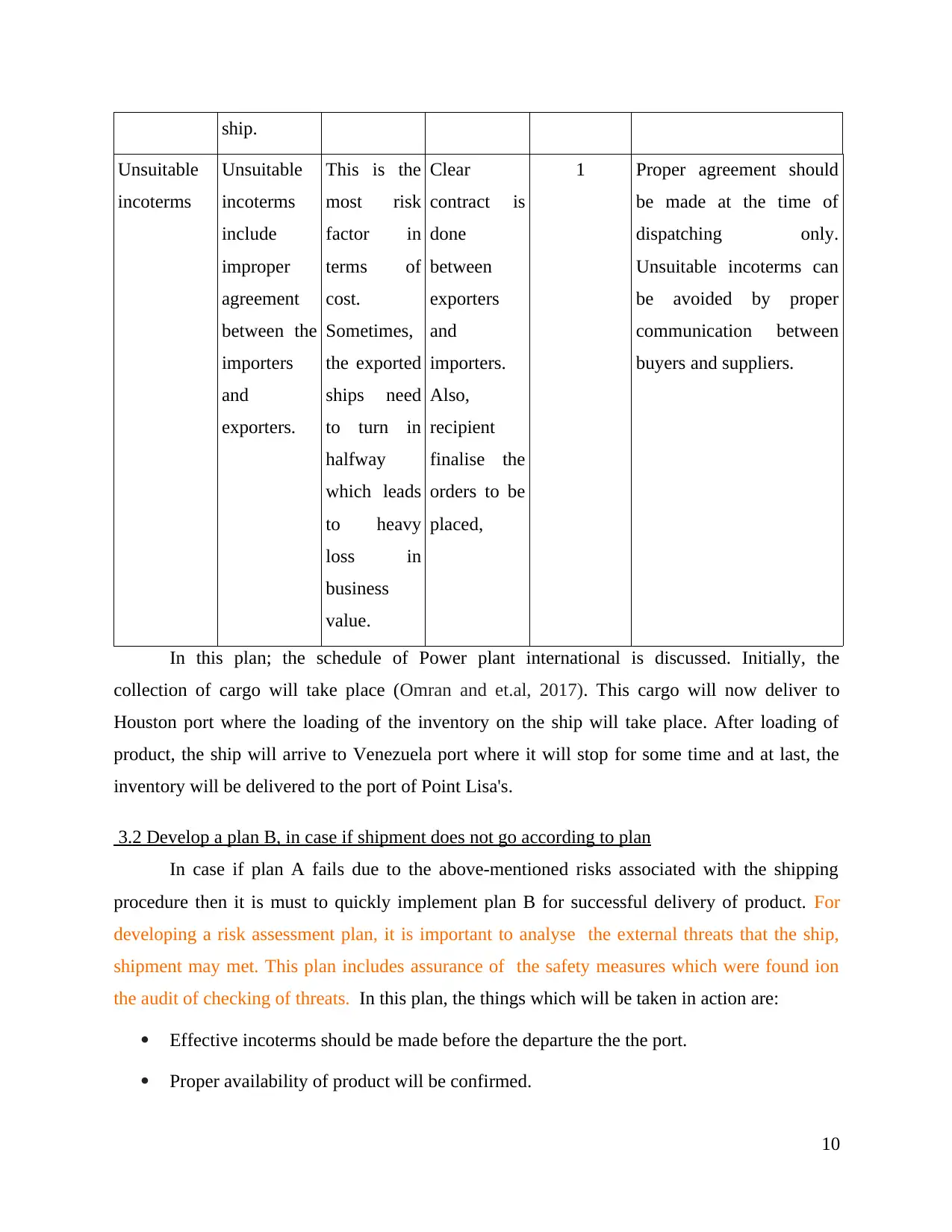
ship.
Unsuitable
incoterms
Unsuitable
incoterms
include
improper
agreement
between the
importers
and
exporters.
This is the
most risk
factor in
terms of
cost.
Sometimes,
the exported
ships need
to turn in
halfway
which leads
to heavy
loss in
business
value.
Clear
contract is
done
between
exporters
and
importers.
Also,
recipient
finalise the
orders to be
placed,
1 Proper agreement should
be made at the time of
dispatching only.
Unsuitable incoterms can
be avoided by proper
communication between
buyers and suppliers.
In this plan; the schedule of Power plant international is discussed. Initially, the
collection of cargo will take place (Omran and et.al, 2017). This cargo will now deliver to
Houston port where the loading of the inventory on the ship will take place. After loading of
product, the ship will arrive to Venezuela port where it will stop for some time and at last, the
inventory will be delivered to the port of Point Lisa's.
3.2 Develop a plan B, in case if shipment does not go according to plan
In case if plan A fails due to the above-mentioned risks associated with the shipping
procedure then it is must to quickly implement plan B for successful delivery of product. For
developing a risk assessment plan, it is important to analyse the external threats that the ship,
shipment may met. This plan includes assurance of the safety measures which were found ion
the audit of checking of threats. In this plan, the things which will be taken in action are:
Effective incoterms should be made before the departure the the port.
Proper availability of product will be confirmed.
10
Unsuitable
incoterms
Unsuitable
incoterms
include
improper
agreement
between the
importers
and
exporters.
This is the
most risk
factor in
terms of
cost.
Sometimes,
the exported
ships need
to turn in
halfway
which leads
to heavy
loss in
business
value.
Clear
contract is
done
between
exporters
and
importers.
Also,
recipient
finalise the
orders to be
placed,
1 Proper agreement should
be made at the time of
dispatching only.
Unsuitable incoterms can
be avoided by proper
communication between
buyers and suppliers.
In this plan; the schedule of Power plant international is discussed. Initially, the
collection of cargo will take place (Omran and et.al, 2017). This cargo will now deliver to
Houston port where the loading of the inventory on the ship will take place. After loading of
product, the ship will arrive to Venezuela port where it will stop for some time and at last, the
inventory will be delivered to the port of Point Lisa's.
3.2 Develop a plan B, in case if shipment does not go according to plan
In case if plan A fails due to the above-mentioned risks associated with the shipping
procedure then it is must to quickly implement plan B for successful delivery of product. For
developing a risk assessment plan, it is important to analyse the external threats that the ship,
shipment may met. This plan includes assurance of the safety measures which were found ion
the audit of checking of threats. In this plan, the things which will be taken in action are:
Effective incoterms should be made before the departure the the port.
Proper availability of product will be confirmed.
10
⊘ This is a preview!⊘
Do you want full access?
Subscribe today to unlock all pages.

Trusted by 1+ million students worldwide
1 out of 21
Related Documents
Your All-in-One AI-Powered Toolkit for Academic Success.
+13062052269
info@desklib.com
Available 24*7 on WhatsApp / Email
![[object Object]](/_next/static/media/star-bottom.7253800d.svg)
Unlock your academic potential
Copyright © 2020–2025 A2Z Services. All Rights Reserved. Developed and managed by ZUCOL.




